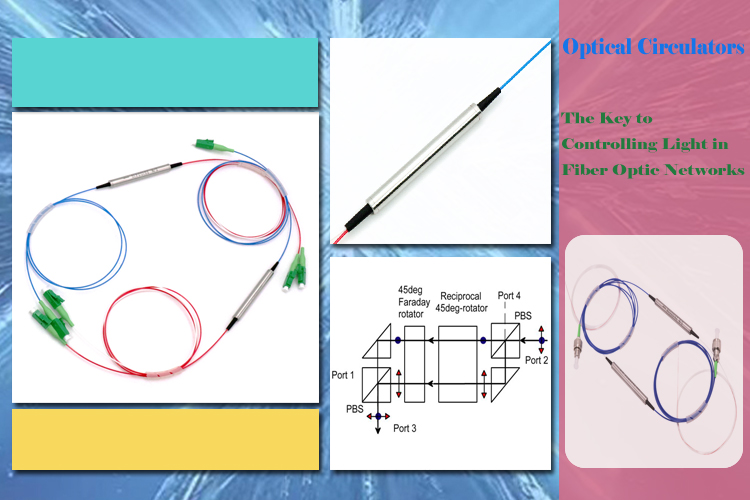Optical Circulators: The Key to Controlling Light in Fiber Optic Networks
Introduction
Optical circulators are versatile non-reciprocal optical devices that are critical components in fiber optic networks and systems. In simple terms, an optical circulator is like a one-way street for light, directing it from one fiber port to the next sequentially in only one direction. Understanding how optical circulators function provides insight into some fascinating physics phenomena and reveals why these devices are so useful for managing uni-directional light propagation.

How Optical Circulators Work
The key to the operation of optical circulators lies in a phenomenon known as Faraday rotation. When a beam of light passes through certain transparent materials called magneto-optic crystals, its polarization direction rotates under the influence of an external magnetic field. The amount of rotation depends on the strength of the magnetic field, the properties of the crystal, and the interaction length. By carefully controlling these parameters, the polarization rotation in an optical circulator can be set to 45°.
Inside an optical circulator, the magneto-optic crystal is positioned between two polarization beam splitters/combiners aligned at 45°. A permanent magnet creates a static magnetic field across the crystal. As light enters from one fiber port, its polarization is rotated 45° by the Faraday effect as it travels through the crystal. This rotated polarization allows it to pass through the next beam splitter and emerge at the second fiber port. Light entering from the second port gets rotated again by 45° as it goes through the crystal in the opposite direction. This time the polarization rotation enables it to be transmitted through the first beam splitter and exit from the third fiber port. In this manner, the light circulation occurs uni-directionally from port 1 to 2 to 3.
Configurations and Applications
Optical circulators are commonly available in two configurations - three-port circulators and four-port circulators. Both types leverage the non-reciprocal polarization rotation to achieve one-way light flow. Four-port circulators have two stages of the Faraday rotator-beam splitter combination, enabling light circulation between four fiber ports.
Some major applications of optical circulators include:
.Isolating optical sources from reflections in fiber optic networks. Circulators prevent reflected light from traveling back into laser sources.
.Implementing bidirectional optical amplifiers. Circulators separate incoming and outgoing signals between amplifier stages.
.Performing add/drop functions in dense wavelength division multiplexing (DWDM) systems. Different wavelength channels can be added or removed from circulation.
.Constructing optical time-domain reflectometers for fiber fault detection. Circulators distinguish backscattered light from test pulses.
Compared to alternatives like optical isolators, optical circulators provide lower insertion loss, higher isolation between ports, and more flexibility in routing multiple uni-directional optical paths. Their non-reciprocal capabilities make circulators ideal for handling duplex communications and interactions between multiple optical components.
Conclusion
Optical circulators enable fiber optic systems and networks to efficiently manage and control the propagation of light. By exploiting magneto-optic effects like Faraday rotation, circulators can break reciprocity and force light to circulate uni-directionally between ports. Understanding the internal operation of optical circulators provides insight into their widespread use in applications ranging from telecommunications to sensing. Continued research and development promises to further enhance optical circulator performance and enable new ways of controlling light for future photonics technologies.
FAQs
Q1.What is the main difference between an optical circulator and an optical isolator?
An optical isolator is a two-port non-reciprocal device that allows light to pass in one direction but blocks it in the reverse direction. This provides isolation between a light source and any reflected signals. An optical circulator is a multi-port device, usually with three or four ports, that circulates light sequentially between the ports in only one direction. Circulators provide isolation while also routing signals between multiple ports.
Q2.What kind of materials are used to make the magneto-optic crystal inside optical circulators?
Some common magneto-optic materials used are yttrium iron garnet (YIG), bismuth-substituted rare-earth iron garnets, and the parent ferrimagnetic garnet. These materials possess a large Faraday rotation per unit length, low optical absorption, and can generate the 45° non-reciprocal polarization rotation needed in optical circulators.
Q3.How do optical circulators enable bidirectional optical amplifiers?
In a bidirectional EDFA amplifier, an optical circulator separates the incoming and outgoing signals between the two amplifier stages. The incoming signal enters port 1, gets amplified by the first stage EDFA connected to port 2. Port 3 is coupled to the second stage EDFA which amplifies the signal for outbound transmission from port 3. The circulator prevents the amplified light from each stage from interfering with the input signal.
Q4.What conditions can degrade the performance of optical circulators?
Factors like temperature variations, mechanical stress, and radiation can affect the properties of the internal magneto-optic crystal and permanent magnet. This disrupts achieving the precise 45° Faraday rotation needed for circulation. Poor optical isolation between ports, high insertion loss, and reflections can occur if conditions alter circulator operation. Proper packaging, shielding, and cooling help maintain stable performance.
Q5.How does using optical circulators enhance the performance of dense wavelength division multiplexing (DWDM)?
In DWDM systems, optical circulators enable individual wavelength channels to be added or dropped from a multi-wavelength fiber link. This allows more flexibility in configuring bi-directional optical networks. Circulators also prevent reflections from DWDM components like multiplexers from traveling back and causing interference. This improves overall optical signal integrity.
Keywords:
optical circulators, non-reciprocal, Faraday rotation, magneto-optic, fiber optics, DWDM, optical networks, polarization

 The Future of Fiber Optic Communication Network Architecture: Evolution and the Role of SDON Technology
The Future of Fiber Optic Communication Network Architecture: Evolution and the Role of SDON Technology
 What opportunities and challenges does free-space optical communication technology face?
What opportunities and challenges does free-space optical communication technology face?
 Opelink MPO Products for High-Speed Data Center Applications
Opelink MPO Products for High-Speed Data Center Applications
 CWDM vs. DWDM: Which Optical Transmission Technology Should You Choose?
CWDM vs. DWDM: Which Optical Transmission Technology Should You Choose?